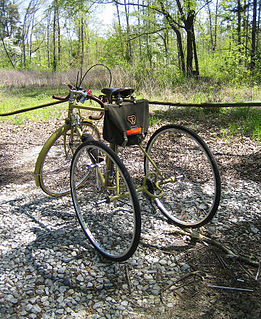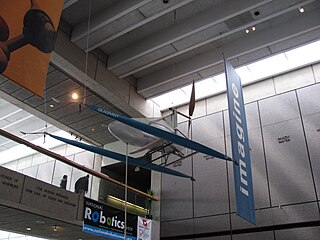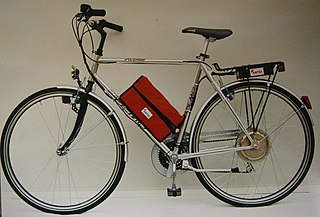
A bicycle, also called a pedal cycle, bike or cycle, is a human-powered or motor-powered assisted, pedal-driven, single-track vehicle, having two wheels attached to a frame, one behind the other. A bicycle rider is called a cyclist, or bicyclist.

Human-powered transport is the transport of person(s) and/or goods using human muscle power. Unlike animal-powered transport, human-powered transport has existed since time immemorial in the form of walking, running and swimming. Modern technology has allowed machines to enhance human-power.

A tandem bicycle or twin is a form of bicycle designed to be ridden by more than one person. The term tandem refers to the seating arrangement, not the number of riders. Patents related to tandem bicycles date from the mid 1880s. Tandems can reach higher speeds than the same riders on single bicycles, and tandem bicycle racing exists. As with bicycles for single riders, there are many variations that have been developed over the years.

A tricycle, sometimes abbreviated to trike, is a human-powered three-wheeled vehicle.

The penny-farthing, also known as a high wheel, high wheeler or ordinary, was an early type of bicycle. It was popular in the 1870s and 1880s, with its large front wheel providing high speeds and comfort.

Vehicles that have two wheels and require balancing by the rider date back to the early 19th century. The first means of transport making use of two wheels arranged consecutively, and thus the archetype of the bicycle, was the German draisine dating back to 1817. The term bicycle was coined in France in the 1860s, and the descriptive title "penny farthing", used to describe an "ordinary bicycle", is a 19th-century term.

Decavitator is a human-powered hydrofoil equipped with pedals and an air propeller that was built by the Massachusetts Institute of Technology. It holds the human-powered speed record on water. The vehicle was displayed hanging in the entry lobby of the Museum of Science, Boston until 2015. It is currently in storage at MIT.

The dandy horse, a derogatory term for what was first called a Laufmaschine, then a vélocipède or draisienne, and then a pedestrian curricle or hobby-horse, is a human-powered vehicle that, being the first means of transport to make use of the two-wheeler principle, is regarded as the forerunner of the bicycle. A dandy horse is powered by the rider's feet on the ground instead of the pedals of later bicycles. It was invented by Karl Drais in 1817, and then patented by him in France in February 1818 using the term vélocipède. It is also known as a Draisine, and as a draisienne (French: [drɛzjɛn] in French and English. In English, it is also sometimes still known as a velocipede, but that term now also has a broader meaning.

A motorized bicycle is a bicycle with an attached motor or engine and transmission used either to power the vehicle unassisted, or to assist with pedalling. Since it sometimes retains both pedals and a discrete connected drive for rider-powered propulsion, the motorized bicycle is in technical terms a true bicycle, albeit a power-assisted one. Typically they are incapable of speeds above 52 km/h (32 mph).

An electric bicycle is a motorized bicycle with an integrated electric motor used to assist propulsion. Many kinds of e-bikes are available worldwide, but they generally fall into two broad categories: bikes that assist the rider's pedal-power and bikes that add a throttle, integrating moped-style functionality. Both retain the ability to be pedaled by the rider and are therefore not electric motorcycles. E-bikes use rechargeable batteries and typically are motor-powered up to 25 to 32 km/h. High-powered varieties can often travel more than 45 km/h (28 mph). In some markets, such as Germany as of 2013, they are gaining in popularity and taking some market share away from conventional bicycles, while in others, such as China as of 2010, they are replacing fossil fuel-powered mopeds and small motorcycles.
Pedal-powered vehicle may refer to:

A dicycle is a vehicle with two parallel wheels, side by side, unlike single-track vehicles such as motorcycles and bicycles, which have two wheels inline. Originally used to refer to devices with large wheels and pedals, the term is now used in relation to powered self-balancing scooters with smaller wheels and no pedals such as the Segway PT and the self-balancing hoverboard.

A balance bicycle, run bike or no pedal bike or dandy horse is a training bicycle that helps children learn balance and steering. It has no foot pedals, no drivetrain, no chain, no gears, no gear shifters, no derailleurs, and no freewheel.

A human-powered hydrofoil is a small hydrofoil watercraft propelled entirely by the muscle power of its operator(s). Hydrofoils are the fastest water-based vehicles propelled solely by human power. They can reach speeds of up to 34 km/h, easily exceeding the world records set by competitive rowing which stand at about 20 km/h. This speed advantage is achieved since hydrofoils lack a submerged body to provide buoyancy, greatly reducing the drag force.

A quadracycle is a four-wheeled human-powered land vehicle. It is also referred to as a quadricycle, quadcycle, pedal car or four-wheeled bicycle amongst other terms.

Bicycle drivetrain systems are used to transmit power on bicycles, tricycles, quadracycles, unicycles, or other human-powered vehicles from the riders to the drive wheels. Most also include some type of a mechanism to convert speed and torque via gear ratios.

The Michaux-Perreaux steam velocipede was a steam powered velocipede made in France sometime from 1867 to 1871, when a small Louis-Guillaume Perreaux commercial steam engine was attached to a Pierre Michaux manufactured iron framed pedal bicycle. It is one of three motorcycles claimed to be the first motorcycle, along with the Roper steam velocipede of 1867 or 1868, and the internal combustion engine Daimler Reitwagen of 1885. Perreaux continued development of his steam cycle, and exhibited a tricycle version by 1884. The only Michaux-Perreaux steam velocipede made, on loan from the Musée de l'Île-de-France, Sceaux, was the first machine viewers saw upon entering the Solomon R. Guggenheim Museum rotunda in The Art of the Motorcycle exhibition in New York in 1998.

Human-powered watercraft are watercraft propelled by human power.




















